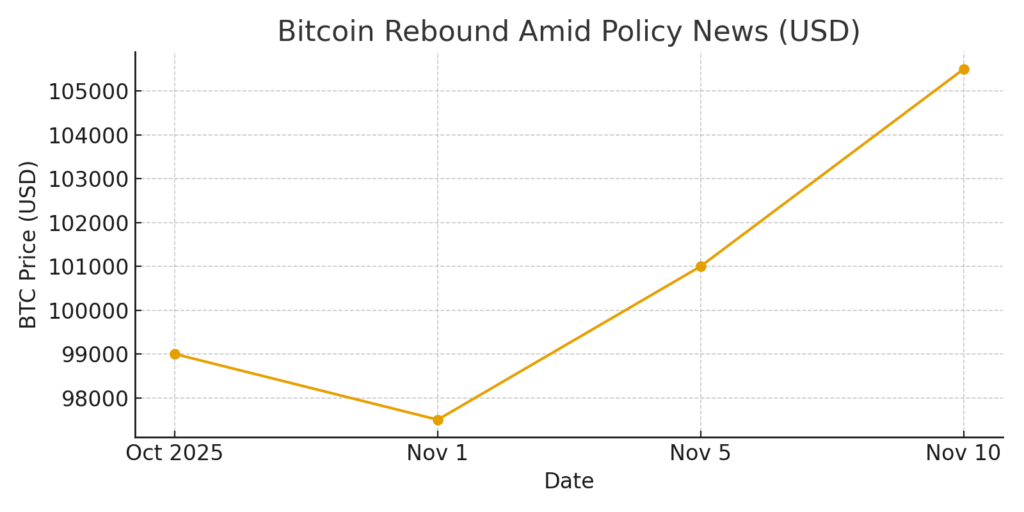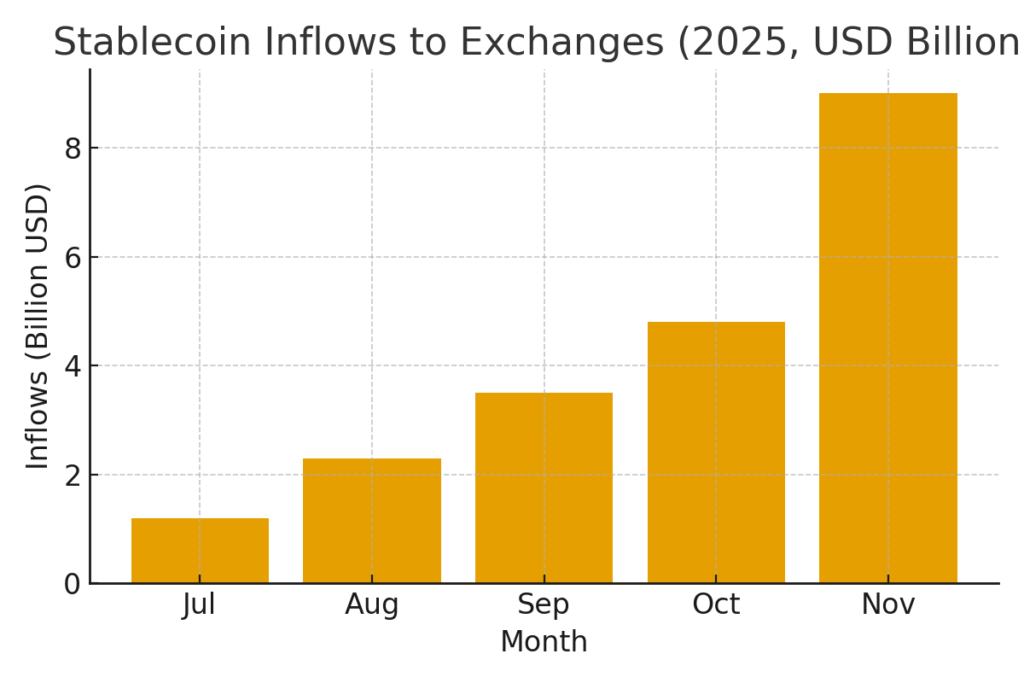
Main Points :
- The price of Bitcoin (BTC) rebounded to around US$105,500, recovering from a temporary dip below the psychological US$100,000 level.
- Key catalysts include a proposed per-person US$2,000 “tariff dividend” by President Trump and expectations of the end of the US government shutdown.
- On-chain metrics show exchange stable-coin reserves swelled (≈ US$9 billion in one month) and BTC exchange reserves hit multi-year lows, suggesting accumulation ahead of a potential rally.
- Derivatives-market metrics (open interest, funding rate) show signs of overheating, raising risks of a sharp pull-back if the US$100K hold fails.
- Institutional commentary (e.g., Coinbase) sees recent liquidations as a “reset” rather than end of cycle, with funds redirecting into EVM-chains, RWA tokenization and yield protocols rather than a broad “new money” influx.
- For investors interested in new crypto assets, the environment suggests a rotation from speculative leverage to more structural plays—yield protocols, tokenization of real-world assets, altcoins benefiting from renewed liquidity flows.
1. Price Recovery and Macroeconomic Triggers

The digital-asset market recently witnessed a meaningful rebound in Bitcoin (BTC), with the coin pushing back up to roughly US$105,500—representing a gain of around +2.99 % on the day. The rebound followed an intra-week dip below the psychological US$100,000 threshold, which had generated concern across traders and analysts.
One of the primary triggers behind this rebound is the announcement by Donald Trump of a proposal to deliver US$2,000 (≈ ¥300,000) to each eligible citizen under a so-called “tariff dividend” scheme. This policy is reminiscent of the large-scale stimulus packages of 2020 and 2021, which coincided with major liquidity injections that helped propel Bitcoin from ~US$3,000 in March 2020 to nearly US$69,000 by the end of 2021.
Market participants drew parallels: with broader crypto awareness today significantly higher (especially among younger investors), a new round of direct payments could spark greater flows into both equities and digital assets.
In addition, reports that the lengthy US government shutdown—one of the longest on record—is approaching resolution further boosted risk-asset sentiment. A re-opening of government operations reduces fiscal uncertainty and may accelerate approvals for alt-coin spot ETFs—another potential tailwind for crypto valuations.
2. On-Chain Evidence: Stable-Coin Accumulation and BTC Supply Shock

Beyond macro-stimulus and policy catalysts, the on-chain data paints an intriguing picture of positioning ahead of a potential move higher. According to data from CryptoQuant, stable-coin balances on exchanges surged by approximately US$9 billion in the past month—marking the largest such increase in 2025 to date. On many occasions historically, large inflows of stable-coins into exchange wallets have preceded significant upward moves in major cryptocurrencies, as buying power is staged on-chain before execution.
Simultaneously, exchange reserves of Bitcoin have dropped to multi-year lows—consistent with a tightening supply environment. This suggests a structural de-risking of readily “sellable” supply, raising the odds that upcoming rallies may face less resistance.
For crypto investors seeking new opportunities beyond bitcoin, the confluence of incremental liquidity and restrained supply may create a favourable setup for alt-coins—especially those delivering yield, real-world-asset tokenization, or bridging between DeFi and on-chain institutional capital flows.
3. Derivatives Market Dynamics: Caution Flags
While the spot market shows encouraging signals, derivatives markets are flashing caution-flags. The recent uptick in open interest (OI) and funding rates indicates that leverage is building—heightening the risk of a sharp correction if the move fails to gain broader conviction. If Bitcoin fails to hold key support (near US$100,000) and the dollar turns strong, forced liquidations could cascade, dragging even fundamentally sound assets down.
Analysts caution that while the technicals look favourable, the structural repositioning of capital (from speculative high-leverage trades to more measured accumulation) is still underway, and may entail volatility as part of the transition.
4. Institutional View: “Reset, Not End of Cycle”

In commentary released by Coinbase, the platform argued that the large-scale liquidation event of October (sometimes labelled the “Trump tariff shock”) is unlikely to mark the end of the crypto cycle. Instead, it may have served as a necessary reset—removing excess leverage, reducing over-hang and paving the way for more stable accumulation by institutions.
Notably, the commentary points to capital flows into areas such as EVM-compatible chains, real-world-asset (RWA) tokenization and yield protocols, rather than broad “new money” chasing every alt-coin.
For developers, token issuers and protocol teams, this signals that the next move may favour infrastructure, utility and real-world connections (e.g., tokenised real estate, trade-finance on-chain), over purely speculative assets. Therefore, projects rooted in yield generation, cross-chain infrastructure and real-asset bridging may merit renewed attention.
5. Implications for Investors Seeking New Crypto Assets and Revenue Streams
For asset hunters and blockchain practitioners seeking fresh opportunities in this environment, several strategic take-aways emerge:
- Look beyond bitcoin and the headline assets. With Bitcoin potentially entering a consolidation‐to‐ramp phase, alt‐coins tied to real-world use-cases (RWA, cross-chain bridges, yield protocols) may benefit from the renewed liquidity flows.
- Monitor stable-coin staging and exchange reserve metrics. Sharp increases in stable-coins on exchange wallets can precede significant asset price moves; likewise, a falling supply on-exchange enhances the case for accumulation.
- Beware of derivative heat. Elevated leverage increases risk: if macro conditions turn (e.g., dollar strength, stimulus disappointment), corrections can be swift—so protocols and tokens with strong fundamentals may offer safer entry points.
- Structural flows over hype moves. Institutional capital is showing signs of repositioning—not simply chasing memes or short-term pumps. Projects that enable institutional entry (reg-friendly infrastructure, tokenised real-world assets, yield aggregators) may see disproportionate benefit.
- Policy catalysts matter. The interplay of fiscal stimulus (direct payments), government operations (shutdown resolution), and regulatory openings (spot ETF approvals) may act as thematic levers for the next phase of market expansion.
6. Summary & Conclusion
In sum, the rebound of Bitcoin to around US$105,500 reflects a complex set of converging factors: macro stimulus hopes via a US$2,000 per-person payment proposal, optimism over an end to the US government shutdown, and strong on-chain accumulation metrics pointing to staged buying and tightening supply.
Yet the market is not without risks: derivatives markets show signs of built-in leverage, and if support levels break or macro conditions deteriorate (for example, a strong US dollar or weak fiscal response), there is a risk of sharp pull-backs. Institutional commentary suggests that we are in a “reset” phase rather than an end of cycle, and that capital is rotating into more structural areas of crypto infrastructure and real-world-asset tokenization.
For investors and blockchain practitioners hunting for fresh revenue streams and assets, this environment suggests a shift away from brute-force speculative tactics toward more selective accumulation of assets tied to real-world utility, institutional entry pathways and yield generation. Monitoring exchange stable-coin reserves, Bitcoin supply on-exchange, and derivative market signals may provide early warning and opportunity.
In conclusion: the stage might be set for the next leg of crypto market expansion — but success may belong to those who focus on infrastructure, utility and institutional connectivity, rather than chasing the loudest headline names.

